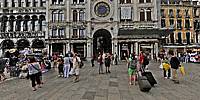
Clock Tower at St. Mark's Square
Piazza San Marco, Venezia, Italy - A World Heritage Site
June 22, 2009, 2:30 pm
The Moors’ Clock Tower is one of the most famous architectural landmarks in Venice, standing over an arch that leads into what is the main shopping street of the city, the old Merceria. It marks both a juncture and a division between the various architectural components of St. Mark’s Square, which was not only the seat of political and religious power but also a public space and an area of economic activity, a zone that looked out towards the sea and also played a functional role as a hub for the entire layout of the city.
In short, the Tower and its large Astronomical Clock, a masterpiece of technology and engineering, form an essential part of the very image of Venice. For more than five hundred years, they have measured out the flow of life and history within the city.
The central part was designed in 1496 by Mauro Codussi and houses the clock (whose face shows the phases of the Moon and Sun as well as the signs of the zodiac). Also adorned with a Lion of St. Mark and a niche for a statue of the Madonna, this part of the structure is surmounted by the famous Two Moors Bell. The side wings were added in 1506, and then raised higher in 1755 (to designs by the architect Giorgio Massari)
The clock tower can be visited by appointment.
Lat: 45° 26' 4.42" N
Long: 12° 20' 20.21" E
Elevation: 1 m. above sea level
Precision is: High. Pinpoints the exact spot.
En el punto más alto de la torre hay dos estatuas de bronce, conocidas como los “moros”, por la pátina oscura, que, gracias a un mecanismo complejo, marcan las horas tocando la campana. Si se encuentran enfrente de la torre, a la derecha se ve Piazzetta dei Leoncini, que se llama así por los dos leones de mármol del siglo XVIII.



 Tap or click the zoom icon in the bottom right corner of the picture to switch between in-page and fullscreen view
Tap or click the zoom icon in the bottom right corner of the picture to switch between in-page and fullscreen view